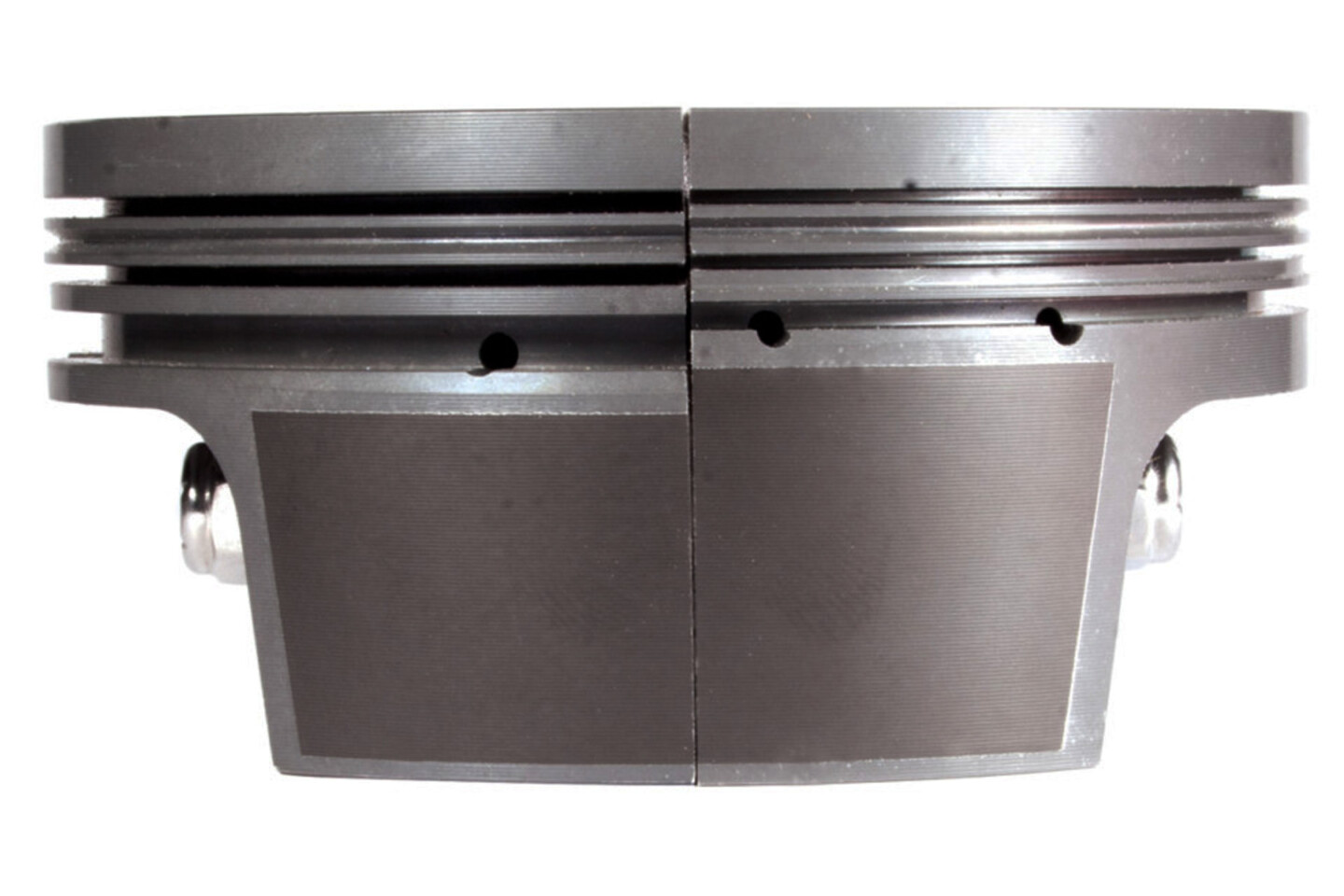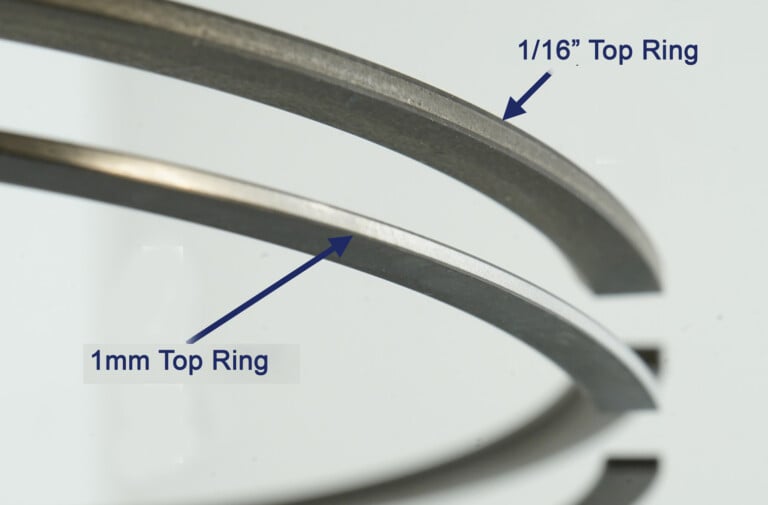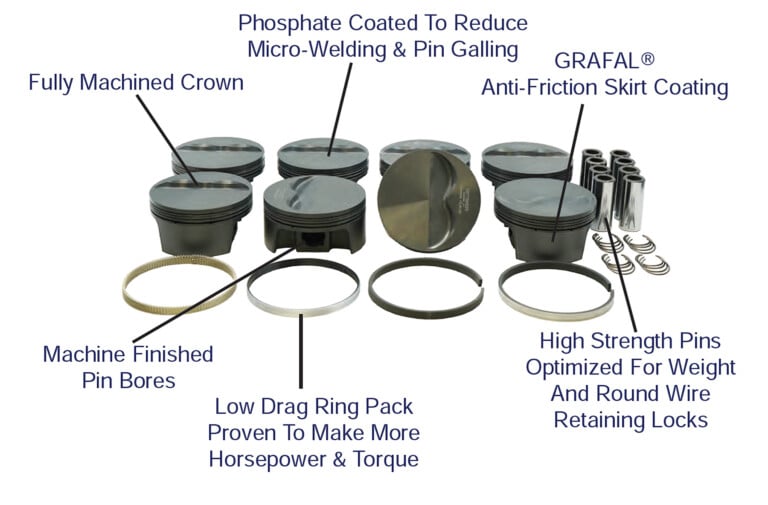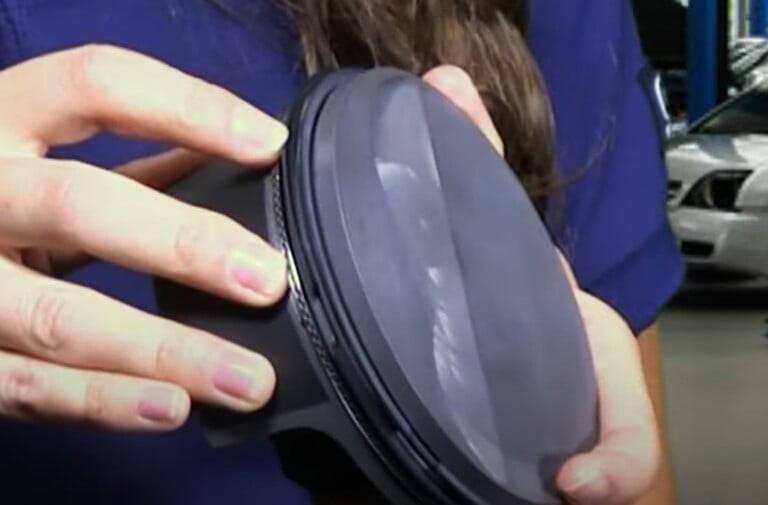The Advantages Of Running Thinner Piston Rings
The quest for more engine efficiency has auto manufacturers adopting thinner rings for greater efficiency when it comes to the family sedan. MAHLE has also embraced this technology, and much more in its motorsports division.
MAHLE Motorsports adopted a new thinner ring technology for performance and racing applications a few years back. The next stage for MAHLE is to educate racers about how these unique rings function and spell out the benefits for their next engine project.

This side-by-side example of piston designs compares a 1.5mm, 1.5mm, and 3.0mm ring pack (left) beside a 1.0mm, 1.0mm, and 2.0mm ring pack MAHLE cinches up the ring pack with thinner rings, versus leaving the ring grooves in the same location as they would with thicker rings.
We asked Joe Maylish, program manager for the MAHLE North American motorsports division, if material advancements sparked the new narrow rings compared to the thicker rings that have been the norm in the high-performance world for many years. His response is, “Yes, and more.”
Materials And Manufacturing Techniques
“Material is one of the factors,” says Maylish. “MAHLE produces a huge volume of piston rings per year for automotive manufacturers and other applications. The volume of specialized raw materials we use with rings on the OEM side allows us to also engineer and manufacture effective rings for motorsports with an extension of that cutting-edge technology.”
Typically, piston rings can be constructed with different raw materials such as alloys of cast iron and varied steel materials, along with a variety of coatings on the ring face, like gas-nitriding, adding wear resistance to the face of a ring.

MAHLE is a well-regarded supplier of coated pistons for motorsports. Their Power Pak piston sets have the option of their “thin ring” technology for performance and racing enthusiasts.
Engineers at MAHLE have developed a 1mm top compression ring , 1mm second compression ring , and a 2mm oil control ring assembly pack that minimizes friction and maximizes sealing between the rings and your engine’s cylinder walls.
“Few would argue against the ability of thinner rings to free up horsepower in the right application,” states Maylish. “The typical concern from the racing world is usually first if they will last, and second, are they worth it? So, we asked our engineering team these questions to be able to convey answers to the racers.”
A 1.0mm compression ring can have up to 50-percent less mass compared to 1/16-inch rings. That equals a 50-percent reduction in the inertial force on that individual ring, plus an increased ring-to-piston groove seal.
Durability
The modern ring pack is much more than just “thin.” In a departure from the typical materials, MAHLE’s metallurgical engineering advancements for these thinner ring packs rely on high-strength steel alloys. MAHLE’s new steel creates a ring far more durable than any cast-iron or ductile-iron option, which achieves proper sealing, thinner size, and less wear in motorsports applications.
The E9254 chrome-silicon steel used in the 1mm top ring successfully minimizes friction and is 35-percent stronger than any cast- or ductile-iron option. With this improved steel comes the ability to produce thinner rings that match the strength of thicker iron rings. The chrome silicon steel contains metallurgical advantages. The materials allow it to achieve ultra-flat ring flanks and a precision finish without machining damage. These two materials also maximize cuff resistance and ring-to-piston sealing.
Less tension by these rings throughout all four strokes of the engine results in less wear on the face of the rings, less drag on the rotating assembly, and less wear on the cylinder walls. – Joe Maylish, Mahle Motorsport
Reduced reciprocating mass is another strong point of the ring. With less mass, the piston and ring can travel up and down faster with higher RPM because of the lessened inertia points at the top and bottom dead center. According to Maylish, at these inertial points, this weight reduction can reduce or eliminate what is called “ring flutter,” which can decrease the ring-to-piston groove seal.
“Granted, you can apply these better materials to any size rings, but that will not overcome the differences in the cross-sectional area with the thinner rings,” Maylish says. “Those smaller dimensions make the rings lighter and more conformable.”
Maylish adds, “This means you can design rings with less radial tension to achieve the same or better combustion gas sealing than a thicker ring. Furthermore, less tension throughout all four strokes of the engine results in less wear on the face of the rings, and less wear on the cylinder walls.”
Steel is also a better conductor of heat and can withstand a longer duration of high-temperature operation without concern for the rings losing tension.
The PowerPak piston line from MAHLE Motorsport offer a long list of included features that were once reserved as options or supplied by separate companies. Off the shelf, these pistons feature full crown machining and coated crowns and skirts. Now, the PowerPak piston sets are available with this new ring technology.
Ring Face Coating
The top ring in the 1.0, 1.0, and 2.0mm pack includes MAHLE’s patented HV385 thermal spray process. This coating is applied to the face of the top ring to improve bond strength of the 9254 steel underneath, as well as durability, and scuff resistance.
“This sprayed material actually becomes embedded into the top ring,” Maylish discloses. “The material is applied through a supersonic, thermal spray process with a liquid-oxygen-powered gun. The HV385 material impregnates itself into the ring face.”
Ring Tension
The fundamentals of all ring designs call for the ring to be formed into a larger diameter than the mating cylinder bore. When installed, the compressed ring tries to expand to its natural diameter and pushes against the cylinder wall; that is called “tension.”
“The conformity of the steel material means you can design rings with less radial tension to achieve the same or better combustion gas sealing than a thicker ring,” Maylish explains. “Older ring designs rely on a comparative ‘brute’ tension force for piston sealing.”
MAHLE’s thermal spraying consists of fine droplets of HV385 material exposed to high temperature and sprayed with supersonic velocity into the face of the top ring made of 9254 steel. Electric or manual ring filing procedures for setting your instructed ring gaps use traditional methods.
The second 1.0mm ring is a reverse-twist taper-faced steel, and the oil rings are standard-tension oil control rings, all with a specific tension designed into them.
Optimizing Seal
The engine bore is not perfectly round for any engine under power. The stresses on the bore — mechanical loading, deformation, and high temperatures — distort the bores. This distortion is typically measured in microns. It sounds minute, but those stressed bore shapes allow cylinder pressure to escape the combustion area past the rings.
MAHLE pioneered computer simulation software and other development tools that successfully minimized friction without sacrificing sealing capabilities. Maylish states, “These rings’ ability to conform to the cylinder walls increased measurable horsepower gains on the dynamometer during our development process. Furthermore, less tension throughout all four strokes of the engine results in less wear on the face of the rings and less wear on the cylinder walls.”
The PowerPak piston sets from MAHLE Motorsports are available with traditionally dimensioned ring sets or the newer 1.0, 1.0, and 2.0mm options. Here is your typical big-block Chevy piston set with the thin ring option.
Strengthen The Piston
These thinner ring sets also allow the MAHLE engineers to develop new piston designs with shorter ring packs that eliminate the wrist pin bore from intersecting the oil ring groove. This clearance is a big plus for many small-block and LS engines. Now, the pin bore has space to sit below the oil ring groove, eliminating the need for support rails, which improves overall piston strength.
New technology for racing is on a constant quest for stronger, lighter, and better-performing designs. There is no question that these thinner MAHLE rings are an effective addition to the motorsports world, since they meet those criteria.
Not just a fad diet, the results from MAHLE’s dyno research and scores of other independent tests by performance engine builders cite the multiple benefits of piston and ring assemblies to not just be smaller, but to add a critical conformity between the rings and the cylinder wall. This “diet” provides a better seal to prevent compression gases from escaping around the piston, the biggest single job rings have.









